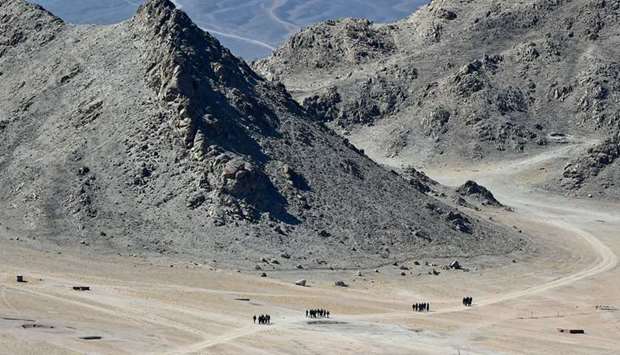China and India have agreed to reduce tensions a week after their deadliest clashes in over 50 years on the disputed Himalayan border left 20 Indian troops dead in brutal hand-to-hand fighting.
The June 15 battle, reportedly fought with fists, clubs and rocks, was the first time troops have been killed on their frontier since 1975 and marked a major deterioration in ties between the two Asian giants.
Chinese foreign ministry spokesman Zhao Lijian said that after talks between the top regional military commanders on Monday, both sides “agreed to take necessary measures to promote a cooling of the situation”.
The Press Trust of India said the meeting was between Lieutenant General Harinder Singh, commander of the 14 Corps, and Major General Liu Lin, commander of the Tibet Military District.
“The holding of this meeting shows that both sides want to deal with their disagreement, manage the situation and de-escalate the situation through dialogue and consultations,” Zhao told a regular news conference.
The two sides “exchanged frank and in-depth views” and “agreed to maintain dialogue and jointly committed to promoting peace and tranquillity in the border areas”, Zhao added.
“There was a mutual consensus to disengage,” an Indian government source said, commenting on the outcome of a parley on Monday that lasted almost 11 hours at the Line of Actual Control (LAC) or the de facto border, high in the western Himalayas.
An Indian army source said that after the meeting, there was a “mutual consensus to disengage”.
He added that ways to reduce frictions in the Ladakh region opposite Tibet “were discussed and will be taken forward by both the sides”.
The meeting came ahead of virtual talks between the foreign ministers of India, China and Russia, ostensibly to discuss the coronavirus and commemorate the end of World War II.
While Indian Foreign Minister S Jaishankar made no direct mention of the clashes in his opening remarks, Russia’s Sergei Lavrov said that Moscow saw no need to mediate between the two countries.
“I don’t think China or India need any help whatsoever,” Lavrov said.
Russia is a major supplier of arms to both countries.
The Times of India reported that Indian Defence Minister Rajnath Singh, in Moscow this week, would press Russia to fast-track delivery of its S-400 missile defence system as well as spares for fighter planes, tanks and submarines.
China has said it suffered casualties but has not given more details.
Indian media reports suggested more than 40 Chinese soldiers were killed or seriously injured.
India has since sent huge reinforcements of soldiers, military equipment and fighter jets into the already highly militarised region.
China is reportedly following suit.
But both sides have observed a long-held protocol to avoid using firearms on the sensitive, high altitude frontier.
In India there have been growing calls for a boycott of Chinese goods.
The clashes followed an earlier agreement to disengage struck in early June after weeks of rising tensions on the border, known as the Line of Actual Control, that included several brawls.
The June 15 violence took place around 4,500m above sea level in the Galwan Valley, where both sides accuse each other of encroaching on their respective territory.
China is claiming all of the valley as its own, which Indian analysts and officials say is a new demand.
Indian government officials say Chinese troops had intruded into India’s side of the poorly defined LAC at three or four locations in India’s Ladakh region, which leads on to the Aksai Chin plateau controlled by China but claimed by India.
Aside from the Galwan Valley, parts of which overlooks a strategically important road, Indian and Chinese troops have also been facing off across the Pangong Lake – a finger of water extending from China’s Tibet Autonomous Region into Ladakh.
“Modalities for disengagement from all friction areas in Eastern Ladakh were discussed and will be taken forward by both the sides,” the Indian government source said.
In previous rounds of talks, China had asked India to stop all construction work in what it says is Chinese territory.
For its part, India has been pushing China to withdraw its troops back to where they were in April.

Indian soldiers walk at the foothills of a mountain range near Leh, the capital of Ladakh yesterday. Indian and Chinese military commanders during their meeting discussed ways to reduce frictions in the Ladakh region opposite Tibet.


